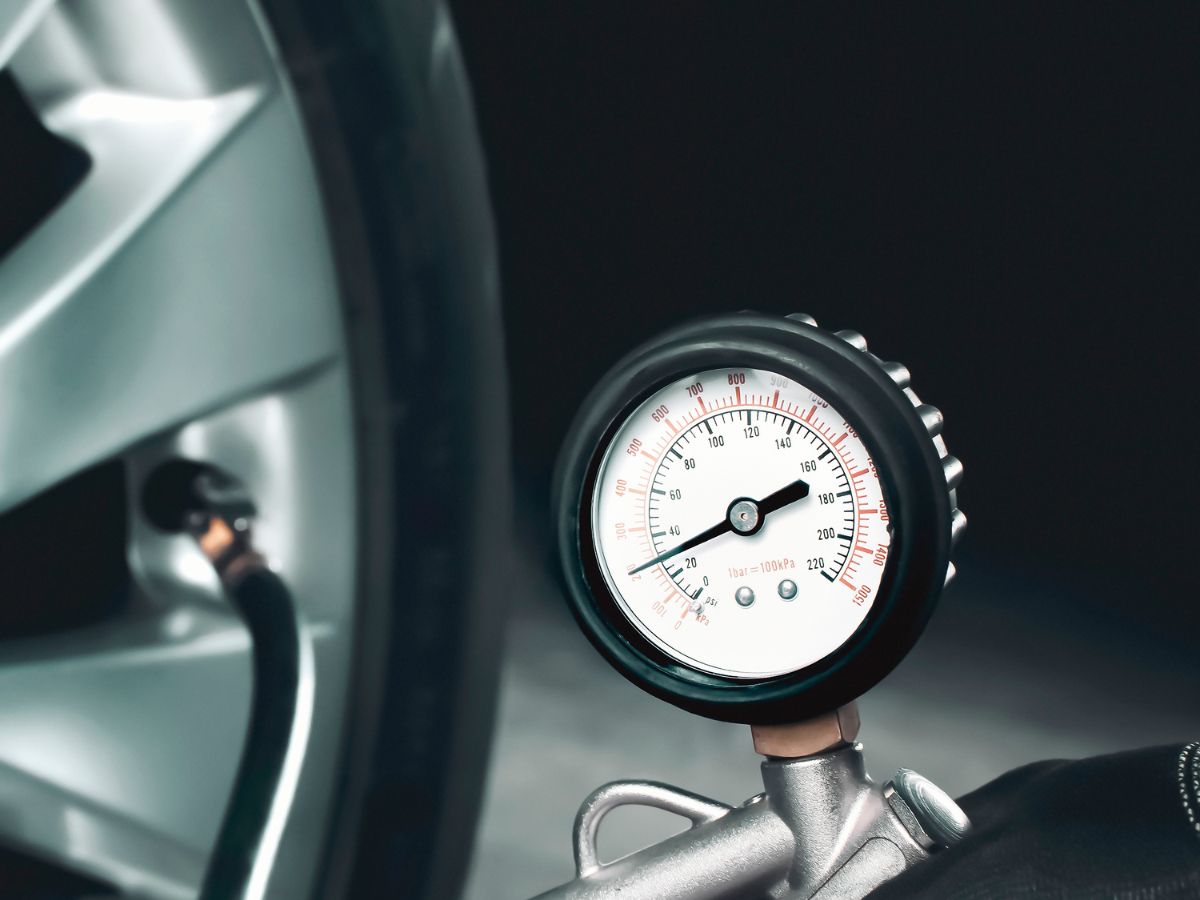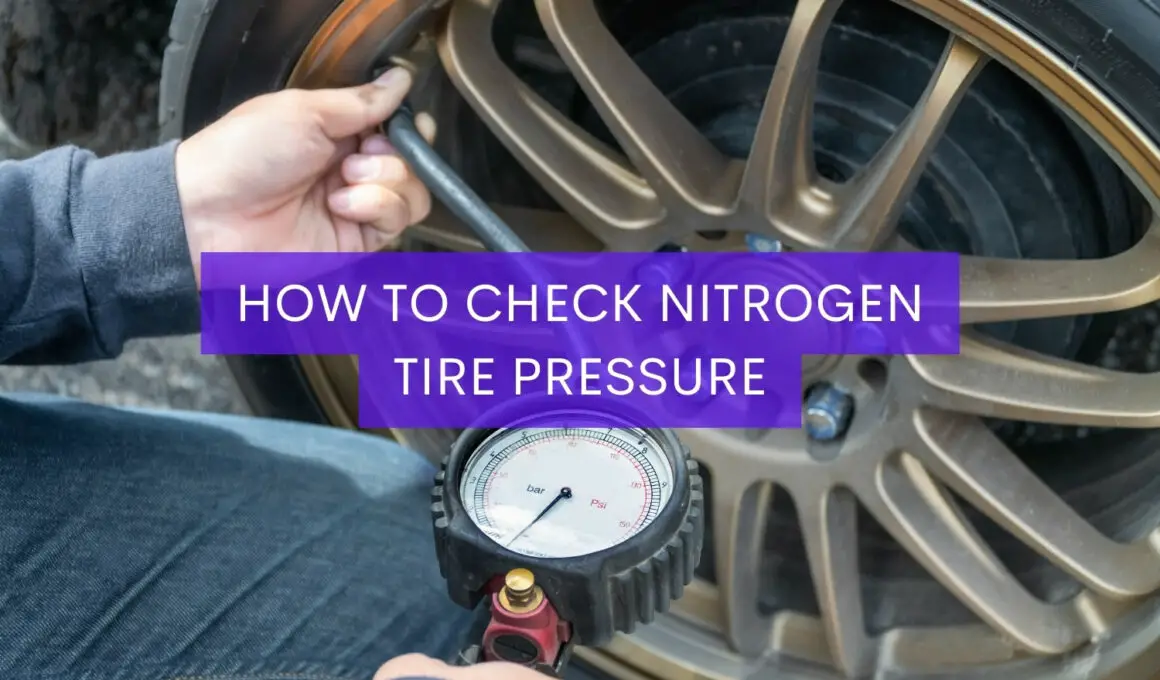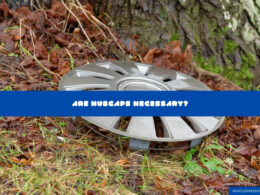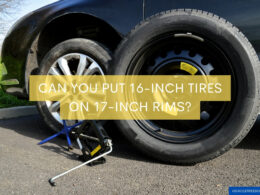In This Article Show
Correct tire pressure is crucial for your vehicle’s overall performance, safety, and fuel efficiency. You might be familiar with the concept of tire pressure, but have you ever heard about nitrogen tire pressure? Don’t worry if you haven’t.
That’s exactly what we’re going to delve into today.
Simply put, nitrogen tire pressure refers to the pressure in a tire filled with nitrogen gas instead of the usual compressed air. You may wonder why someone would fill their tires with nitrogen instead of compressed air. Well, nitrogen has unique benefits when used in tires, including better pressure retention and improved fuel efficiency.
In this post, I will guide you on how to check nitrogen tire pressure, helping you ensure your vehicle’s tires are always in top condition.

Why Nitrogen instead of Compressed Air?
It’s a question I often encounter, and with good reason too. When it comes to tire maintenance, the kind of gas you use to inflate your tires can make a significant difference.
Traditional practice involves using compressed air to inflate tires. It’s convenient, easily accessible, and gets the job done. However, over my years of experience as a mechanic, I’ve seen the distinct advantages of using nitrogen instead.
Firstly, nitrogen is a larger molecule than the oxygen in compressed air. This means it’s less likely to leak out of your tires, leading to more consistent tire pressure over time. Consistent tire pressure equates to smoother rides and longer tire life.
Secondly, unlike compressed air, nitrogen doesn’t carry moisture. Compressed air can contain water vapor, which leads to more pressure fluctuation as the tires heat up and cool down.
In contrast, nitrogen-filled tires experience fewer pressure changes with temperature swings, providing a more predictable and reliable performance.
Finally, proper tire inflation with nitrogen can lead to improved fuel efficiency. When your tires maintain optimal pressure, they provide the best contact with the road and reduce rolling resistance, thereby helping your vehicle run more efficiently.
While nitrogen tire inflation isn’t a magic solution to all tire problems, it’s a practice gaining popularity for these reasons. As an experienced mechanic, I’ve seen firsthand how this shift can benefit a vehicle’s performance and longevity.
However, regular pressure checks are crucial whether you choose to inflate your tires with nitrogen or compressed air.

Preparatory Steps Before Checking Nitrogen Tire Pressure
Before we dive into the actual process of checking your nitrogen tire pressure, there are a few important preparatory steps and considerations to ensure accurate readings.
First, you’ll need the right equipment. A good-quality tire pressure gauge is essential. While some vehicles come equipped with a Tire Pressure Monitoring System (TPMS), a manual gauge can provide a more accurate reading and serve as a reliable backup. Gauges come in several types – digital, dial, and stick – any of which can do the job efficiently.
The next critical factor is the temperature. Tires should ideally be ‘cold’ when you check the pressure. Why is this so? As you drive, the friction between the tires and the road generates heat, causing the air or nitrogen inside the tires to expand and leading to higher pressure readings.
For an accurate reading, check your tire pressure in the morning before driving your vehicle, or wait for at least three hours after driving. This will ensure the tires have cooled down and the pressure inside has stabilized.
One more thing to remember is the location of the tire valve. It’s a small, often overlooked part of the tire that allows you to inflate or deflate the tire. Ensure it’s clean and not clogged with dirt or grime before you attach the tire pressure gauge, as this can also affect your pressure reading.
Now that you have all the necessary information and equipment at hand, let’s move on to the actual steps of checking your nitrogen tire pressure.
Step-by-Step Guide: How to Check Nitrogen Tire Pressure
Now that you’re equipped with the necessary knowledge and tools, let’s walk through the process of checking your nitrogen tire pressure:
1. Remove the valve cap
The valve cap is the small cover that protects the valve from dirt and debris. Twist it counterclockwise to remove it and keep it in a safe place; you don’t want to lose it!
2. Attach the pressure gauge
Place the end of your pressure gauge onto the valve stem. Ensure a good seal to avoid air (or nitrogen) escaping during the check. If you hear a hissing sound, that’s likely air escaping, so you may need to adjust the gauge for a better fit.
3. Read the pressure
Once your gauge is securely fitted, read the tire pressure on the gauge. If you’re using a digital gauge, the reading should appear on the screen. The needle or stick will move to show the pressure for dial or stick gauges.
4. Compare the reading to the recommended pressure
Your vehicle’s recommended tire pressure can typically be found in the owner’s manual or on a sticker inside the driver’s door. Compare your reading to this recommended pressure.
5. Repeat for all tires
It’s essential to check the pressure in all four of your tires. Even if they look fine, the pressure can be too high or too low without it being visible. Don’t forget to check the spare tire if you have one!
6. Replace the valve cap
Once you’ve checked and adjusted the pressure, ensure you replace the valve cap securely.
Remember, this process doesn’t differ for nitrogen-filled tires or air-filled ones. The crucial aspect is the type of gas inside the tire and ensuring it stays at the correct pressure.

How Often Should You Check Your Nitrogen Tire Pressure?
One of the most frequently asked questions about tire maintenance is how often one should check their tire pressure. This is a critical aspect to consider because both over-inflation and under-inflation can lead to problems ranging from uneven tire wear to poor fuel efficiency and even tire failure.
As a rule of thumb, checking your tire pressure at least once a month is advisable. However, certain factors may necessitate more frequent checks:
1. Seasonal Changes
Temperature changes can affect tire pressure. For every 10 degrees Fahrenheit change in air temperature, your tire’s pressure will change by about 1 PSI (Pound per Square Inch).
Cooler temperatures cause tire pressure to drop, while warmer temperatures cause it to rise. As such, at the change of every season, it’s good practice to check your tire pressure.
2. Before Long Trips
If you’re preparing for a long journey, checking your tire pressure before you set off is essential. The last thing you want is to deal with tire issues on the road.
3. Heavy Load
If you carry additional weight in your vehicle, such as luggage or extra passengers, you may need to inflate your tires to a higher pressure. Check your vehicle’s manual for the recommended pressure under these conditions.
Whether your tires are filled with nitrogen or air, regular checks are vital. Nitrogen-filled tires may hold their pressure better but are not immune to pressure changes. Routine checks will help ensure your tires are always at the optimum pressure for maximum performance and safety.
What to Do If Your Nitrogen Tire Pressure is Too Low or Too High?
Understanding what to do when your nitrogen tire pressure is not within the recommended range is equally as important as knowing how to check it. Incorrect tire pressure can have serious consequences, from uneven tire wear to potential tire failure.
If Your Nitrogen Tire Pressure is Too Low:
Under-inflation can lead to increased tire wear and tear, poor vehicle handling, decreased fuel efficiency, and even a tire blowout due to overheating. If you find that your nitrogen tire pressure is lower than the manufacturer’s recommended level, you should inflate your tires accordingly:
- Attach the hose from the nitrogen inflator to the tire valve.
- Fill the tire with nitrogen, periodically checking the pressure with your gauge until it reaches the recommended level.
- Replace the valve cap securely when finished.
If Your Nitrogen Tire Pressure is Too High:
Over-inflation can make the tire stiff and rigid, decreasing traction and making the ride less comfortable. In extreme cases, it can also lead to a blowout. If your nitrogen tire pressure is too high:
- Press the small, metal stem in the center of the tire valve to release some nitrogen.
- Periodically check the pressure with your gauge until it decreases to the recommended level.
- Replace the valve cap securely when finished.
Remember, nitrogen-filled tires should ideally be topped up with nitrogen to maintain the benefits. However, in an emergency, it’s okay to use compressed air.
The most important thing is to keep the pressure within the recommended range for safety and optimal vehicle performance.
Wrapping it up
Maintaining the right tire pressure, particularly nitrogen tire pressure, is a critical aspect of vehicle maintenance that often goes overlooked. As an experienced mechanic with 13 years in the field, I cannot stress enough the importance of regular checks and adjustments to ensure your tires are at the optimum pressure.
Whether you choose to inflate your tires with nitrogen or compressed air, understanding how to check and adjust your tire pressure can significantly impact your vehicle’s performance, safety, and even fuel efficiency.
In this post, we’ve walked through the benefits of using nitrogen in your tires, the preparatory steps before checking your tire pressure, a step-by-step guide on how to check it, and what to do if your nitrogen tire pressure is too low or too high.
Just as every part of a vehicle plays its role, so too does the gas inside your tires. Nitrogen, with its larger molecules and lack of moisture, offers distinct benefits that make it a worthy consideration for your tires. However, the best practices remain: regular checks and adjustments to keep your tire pressure at the manufacturer’s recommended level.












